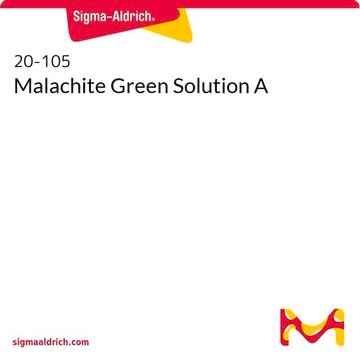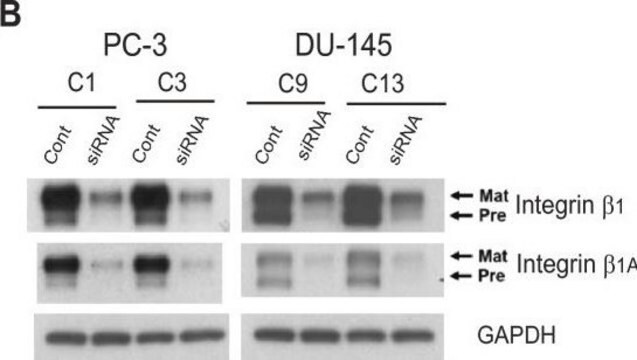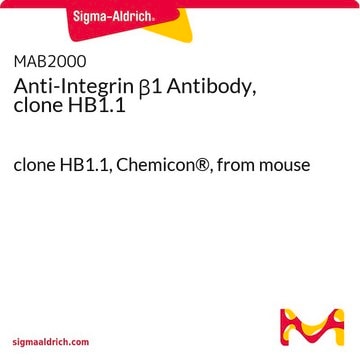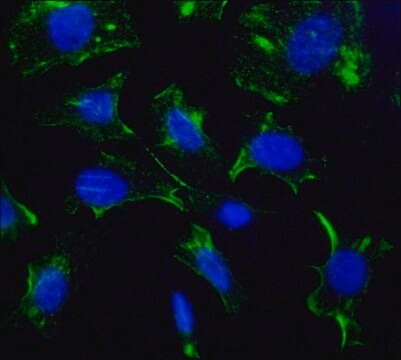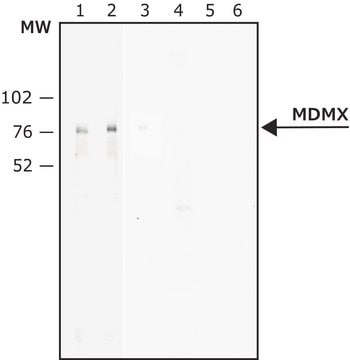MAB1965
Anti-Integrin beta 1 (CD29) Antibody
CHEMICON®, mouse monoclonal, JB1A (J10)
Sinonimo/i:
CD29
Scegli un formato
459,00 €
Spedizione prevista il23 aprile 2025Dettagli
Scegli un formato
About This Item
459,00 €
Spedizione prevista il23 aprile 2025Dettagli
Prodotti consigliati
Nome del prodotto
Anti-Integrin β1 Antibody, a.a. 82-87, clone JB1A (a.k.a. J10), ascites fluid, clone JB1A (J10), Chemicon®
Origine biologica
mouse
Livello qualitativo
100
300
Forma dell’anticorpo
ascites fluid
Tipo di anticorpo
primary antibodies
Clone
JB1A (J10), monoclonal
Reattività contro le specie
human
Produttore/marchio commerciale
Chemicon®
tecniche
flow cytometry: suitable
immunohistochemistry: suitable
immunoprecipitation (IP): suitable
western blot: suitable
Isotipo
IgG1
N° accesso UniProt
Condizioni di spedizione
dry ice
modifica post-traduzionali bersaglio
unmodified
Informazioni sul gene
human ... ITGB1(3688)
Categorie correlate
Descrizione generale
Specificità
Immunogeno
Applicazioni
1:100 Note: epitope is trypsin sensitive; cells should be prepared with PBS + EDTA (2mM) or other non-enzymatic methods. Blocking will not occur with trypsinized cells with JB1A.
Immunoprecipitation: 1:250-500
Western blotting (reducing, 115 kDa; non-reducing, 130 kDa): 1:1000-2000
Note: binding of antibody may be inhibited by magnesium ion concentrations exceeding 0.5mM.
Immunocytochemistry/Immunohistochemistry: JB1A can be used on unfixed cells in flow cytometry and culture {Akimov, 2001; Blood 98(5):1567-1576}. Often times fixing with 2-3% PFA for 5 minutes after primary antibody incubation will assist in obtain strong signals since it fixes the primary antibodies to the tissues.
FACS: JB1A has been primarily used against live cells at 1:200-1:500 followed by goat anti-mouse conjugated secondaries
Optimal working dilutions must be determined by end user.
Cell Structure
Integrins
Descrizione del bersaglio
Stato fisico
Stoccaggio e stabilità
Risultati analitici
Human lung, liver, and skeletal muscle tissues
Altre note
Note legali
Esclusione di responsabilità
Non trovi il prodotto giusto?
Prova il nostro Motore di ricerca dei prodotti.
Raccomandato
Codice della classe di stoccaggio
10 - Combustible liquids
Classe di pericolosità dell'acqua (WGK)
WGK 1
Punto d’infiammabilità (°F)
Not applicable
Punto d’infiammabilità (°C)
Not applicable
Certificati d'analisi (COA)
Cerca il Certificati d'analisi (COA) digitando il numero di lotto/batch corrispondente. I numeri di lotto o di batch sono stampati sull'etichetta dei prodotti dopo la parola ‘Lotto’ o ‘Batch’.
Possiedi già questo prodotto?
I documenti relativi ai prodotti acquistati recentemente sono disponibili nell’Archivio dei documenti.
Filtri attivi
Il team dei nostri ricercatori vanta grande esperienza in tutte le aree della ricerca quali Life Science, scienza dei materiali, sintesi chimica, cromatografia, discipline analitiche, ecc..
Contatta l'Assistenza Tecnica.